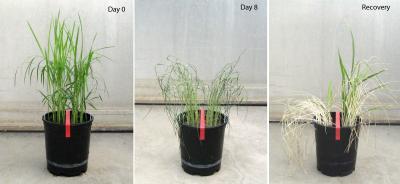RIVERSIDE, Calif. – Rice, which is sensitive to drought due to its high water requirement, is particularly vulnerable to how global climate change is altering the frequency and magnitude of floods and droughts. If rice plants' combined tolerance to flooding and drought could be improved, however, rice productivity could be protected and even substantially increased.
Now plant scientists at the University of California, Riverside have made a discovery that can greatly benefit rice growers and consumers everywhere. The researchers have demonstrated in the lab and greenhouse that rice that is flood tolerant is also better able to recover from a drought.
"Flood tolerance does not reduce drought tolerance in these rice plants, and appears to even benefit them when they encounter drought," said Julia Bailey-Serres, a professor of genetics in the Department of Botany and Plant Sciences, who led the research project.
Bailey-Serres and her team – Takeshi Fukao, a senior researcher, and Elaine Yeung, an undergraduate student – focused on Sub1A, a gene responsible for flood or "submergence" tolerance in rice and found only in some low-yielding rice varieties in India and Sri Lanka. Sub1A works by making the plant dormant during submergence, allowing it to conserve energy until the floodwaters recede. Rice with the Sub1A gene can survive more than two weeks of complete submergence.
Plant breeders have already benefited farmers worldwide – especially in South Asia – by having transferred Sub1A into high-yielding rice varieties without compromising these varieties' desirable traits—such as high yield, good grain quality, and pest and disease resistance.
Bailey-Serres's lab found that in addition to providing robust submergence tolerance, Sub1A aids survival of drought. The researchers report that at the molecular level Sub1A serves as a convergence point between submergence and drought response pathways, allowing rice plants to survive and re-grow after both extremes of precipitation.

The images show rice plants treated with drought, followed by recovery. Each image shows two kinds of rice plants. The plants to the left of the red tape lack the Sub1A gene; the plants to the right of the red tape have Sub1A. The image marked "Day 0" shows the plants when the experiment began. The image marked "Day 8" shows the plants on the eighth day of drought. The image marked "Recovery" shows that only the plants with the Sub1A gene are recovering from drought stress after the pot was regularly watered for 14 days after Day 8.
(Photo Credit: Bailey-Serres lab, UC Riverside)
Study results appear in the January issue of The Plant Cell. The journal has the highest impact factor of primary research journals in plant biology. The research paper also has been selected as a recommended read in the Faculty of 1000.
Bailey-Serres's lab investigated the drought tolerance of flood-tolerant rice plants because her research team wanted to be sure that the flood tolerance trait, which the lab has studied for many years, did not reduce the ability of the plant to endure some of the other common stresses – such as drought.
"We found that Sub1A properly coordinates physiological and molecular responses to cellular water deficit when this deficit occurs independently, as in a time of drought, or following 'desubmergence,' which takes place when flood waters recede," Bailey-Serres said.
She explained that after a flood, a period follows when the leaves that have been submerged lose water and become dehydrated. Moreover, because a period of dehydration is part of the natural progression of a flood, Sub1A also happens to have benefits after desubmergence and is therefore important for drought tolerance as well.
"Our finding suggests that the plant recovers well from drought by growing new shoots," Bailey-Serres said. "This is something that is also seen with flooding."
Next, colleagues of Bailey-Serres at the International Rice Research Institute in the Philippines will test the Sub1A rice for drought tolerance in the field.